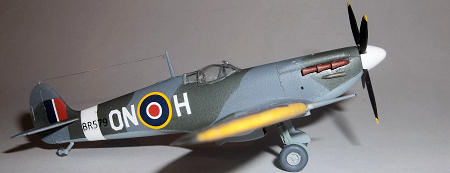| KIT #: | 4007 or 02046 |
| PRICE: | $ |
| DECALS: | One option |
| REVIEWER: | Brian Baker |
| NOTES: |
Easy conversion of a little known variant. |
| HISTORY |
In 1941,
in answer to a perceived threat of high flying Luftwaffe bombers and
reconnaissance aircraft, the RAF ordered the development of a Spitfire variant
designed to reach extremely high altitudes.
While modified Spitfire Mk. V’s were able to destroy a few Junkers
JU-86P’s in the Middle East, the Spitfire Mk. VI was seen as the solution to the
problem in the UK. Taking a
standard Spitfire VB as a basis, the prototype had a high-altitude rated Merlin
45 of 1,415 hp., a four bladed prop, extended wingtips, and a pressurized cabin.
Approximately 100 Mk. VI’s were produced during 1942 and 1943.
The Mk.
VI’s service career was brief, as the pressure cabin was a problem, since pilots
didn’t like the idea of having the canopy screwed down tight, making bailing out
difficult. The plane didn’t perform
quite up to expectations, and it was eventually replaced by the “built for the
purpose” Mk.
| THE KIT |
| CONSTRUCTION |
Probably
the most involved part of the conversion was the creation of the “pointy”
wingtips common to the Mk. VI and Mk.
This
wasn’t a difficult task, but it did require some careful trimming to get the
tips to look right.
I used a
four bladed prop from my spares box, and again, I don’t know the original
source. I probably left off a couple of minor details, but overall, the airplane
looks like a MK. VI, and
I think that is the point. Other than those factors,
the kit went together like a standard Spitfire kit, and this would be a good
model for anyone who hasn’t done conversions but who wants to start doing this
kind of modeling.
This
conversion will require the following changes:
1.
Replace kit prop with four bladed
version and new spinner. (The prop from a Hasegawa Mitsubishi J2M3 Jack is what
I used.)
2.
Cut off
wingtips. Make new ones. Harleyford book has a good three view in 1/72 scale,
3.
Remove
canopy slide tracks and side cabin door.
4.
Add a
slightly longer scoop under the belly.
5.
Retain
tailwheel and exhaust stacks, as these were Mk. V type.
| COLORS & MARKINGS |
 I modeled
the airplane as shown in the Harleyford reference, which is shown in a
black and white tone three view drawing in the book.
The plane is in standard 1943 colors, Dark Green and
I modeled
the airplane as shown in the Harleyford reference, which is shown in a
black and white tone three view drawing in the book.
The plane is in standard 1943 colors, Dark Green and
| CONCLUSIONS |
Try doing this one. It’ll be fun, and you’ll have something different.
| REFERENCES |
The Mk.
VI is covered in most Spitfire histories, including Harleyford’s “Spitfire-the
Story of a Famous Fighter” by Bruce Robertson; William Green”s “Fighters Vol.
2”; and Peter Moss’s “Supermarine Spitfire”, a Dulcimus publication. There is a
Brian Baker
September 2012
Copyright ModelingMadness.com. All rights reserved. No reproduction in any form without express permission from the editor.
If you would like your product reviewed fairly and fairly quickly, please contact the editor or see other details in the Note to Contributors.